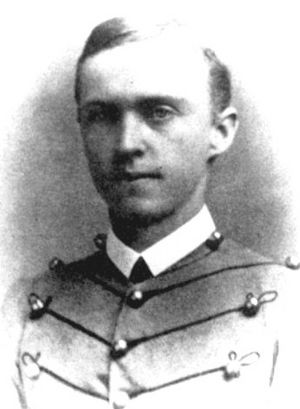John Chowning Gresham facts for kids
Quick facts for kids
John Chowning Gresham
|
|
|---|---|

Gresham as a West Point cadet
|
|
| Born | September 25, 1851 Lancaster County, Virginia |
| Died | September 2, 1926 (aged 74) San Diego, California |
| Place of Burial | |
| Allegiance | United States of America |
| Service/ |
United States Army California National Guard |
| Years of service | 1876–1915 (Army) 1915–1918 (National Guard) |
| Rank | Colonel |
| Unit | 7th Cavalry Regiment |
| Commands held | 10th Cavalry Regiment |
| Battles/wars | Indian Wars Philippine–American War |
| Awards | Medal of Honor |
John Chowning Gresham (September 25, 1851 – September 2, 1926) was an officer in the United States Army. He received the Medal of Honor for his brave actions during the Indian Wars. This is one of the highest awards for military bravery.
After finishing military school, he joined the U.S. Army. He fought in several battles during the Indian Wars, including the Battle of Canyon Creek. He also taught military science at a college in Virginia. Later, he returned to active duty and was injured. He earned his Medal of Honor for his actions during the Battle of Wounded Knee.
He retired in 1915 but was called back to serve during World War I. He led military training programs at the University of Denver. He was part of the California National Guard until these programs ended in 1918. Colonel Gresham passed away in San Diego, California in 1926. He is buried at the San Francisco National Cemetery.
Contents
John Gresham's Early Life and Military Start
John Chowning Gresham was born on September 25, 1851. His hometown was Lancaster County, Virginia. He attended the United States Military Academy. This famous school is often called West Point. He graduated from West Point in 1876.
After graduating, he became a second lieutenant. This is a junior officer rank in the army. He joined the 3rd Cavalry at Fort Abraham Lincoln. Soon after, he moved to the 7th Cavalry. This happened after the Battle of Little Big Horn.
Service in the Indian Wars
Gresham served in the Nez Perce War. He took part in the Battle of Canyon Creek. In June 1878, he was promoted to first lieutenant. He continued to serve in different army posts. These posts were in the Department of Dakota.
From 1884 to 1887, he took a break from combat. He became a Professor of Military Science and Tactics. He taught at the Virginia Agricultural College. This role involved training students in military skills.
In 1887, Gresham returned to the 7th Cavalry. He joined the campaign against the Sioux people. He played a key role in the Battle of Wounded Knee. During this event, he bravely led a group of soldiers. They went into a ravine to face a group of Native Americans. For his courage, he received the Medal of Honor in March 1895.
Promotions and New Assignments
In April 1892, Gresham was promoted to captain. His regiment then moved to Arizona. He again served as a Professor of Military Science and Tactics. This time, he taught at the North Carolina College of Agriculture and Mechanical Arts. He rejoined his regiment in Havana in March 1899.
Gresham continued to rise through the ranks. In September 1901, he became a major in the 6th Cavalry. He traveled to Manila in the Philippines in 1902. He served there with the 6th Cavalry until August 1903. He was part of General J. Franklin Bell's campaign.
He then transferred to the 15th Cavalry. He returned to the United States. He went back to the Philippines with the 15th Cavalry in 1905. He served there until July 1906. After that, he transferred to the 9th Cavalry. He returned to the U.S. once more.
Later Career and Retirement
In July 1907, Gresham was promoted again. He became a lieutenant colonel of the 14th Cavalry. He was given command of the regiment. He also commanded the post at Boise Barracks. In March 1910, his regiment was sent to Fort Stotsenburg in the Philippines.
Gresham reached the rank of colonel in August 1911. In April 1912, he took command of the 10th Cavalry. This unit was stationed at Fort Ethan Allen, Vermont. In December 1913, he took command of Fort Huachuca, Arizona.
From August 1914, he managed militia affairs for the Western Department. He officially retired in September 1915. However, he was immediately called back to active duty. He served with the California National Guard in Los Angeles. Starting in January 1918, he led the ROTC and SATC programs. These programs trained future officers at the University of Denver. They were stopped in December 1918.
Colonel Gresham was also a member of the Sons of the American Revolution. This group honors descendants of those who fought in the American Revolution.
Colonel Gresham passed away on September 2, 1926. He died in San Diego, California. His burial place is the San Francisco National Cemetery.

